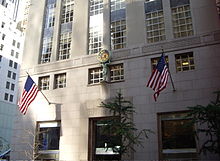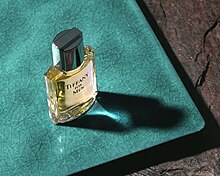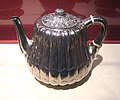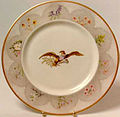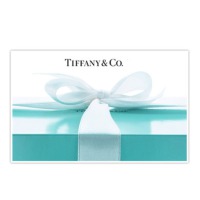
世界百大品牌 – Rank no.75 – US
Top 100 Brand in The World – Rank no.75 – Tiffany & Co. – US
| Type | Public |
|---|---|
| Traded as | NYSE: TIF S&P 500 Component |
| Industry | Jewelers, Silversmiths |
| Founded | September 18, 1837 |
| Founder(s) | Charles Lewis Tiffany, Teddy Young |
| Headquarters | 727 Fifth Avenue New York City, USA 10022 |
| Area served | Worldwide |
| Key people | Michael Kowalski Chairman & CE0 [1] |
| Total assets | |
| Total equity | |
| Employees | 9,800 (2011)[3] |
| Website | Tiffany.com |
Tiffany & Company (NYSE: TIF) (known colloquially as Tiffany or Tiffany’s) is an American multinational luxury jewelry and specialty retailer, having headquarters in New York City, United States. Tiffany sells jewelry, sterling silver, china, crystal, stationery, fragrances, personal accessories, as well as some leather goods.[4] Many of these goods are sold at Tiffany stores, as well as through direct-mail and corporate merchandising. Tiffany is renowned for its luxury goods and is particularly known for its diamond jewelry. Tiffany markets itself as an arbiter of taste and style.
History[edit]

“Tiffany Cross” version of theMedal of Honor
Founded by Charles Lewis Tiffany and John B. Young[6] in New York City in 1837 as a “stationery and fancy goods emporium”, the store initially sold a wide variety of stationery items, and operated as “Tiffany, Young and Ellis” in Lower Manhattan. The name was shortened to Tiffany & Company in 1853 when Charles Tiffany took control and established the firm’s emphasis on jewelry.[7] Tiffany & Company has since opened stores in major cities all over the world. Unlike other stores at the time in the 1830s, Tiffany clearly marked the prices on its goods to forestall any haggling over prices. In addition, against the social norm at the time, Tiffany only accepted cash payments, and did not accept payments on credit.[8]
The first Tiffany’s mail order catalog, known as the “Blue Book,” was published in 1845 in the United States (U.S.);[9] and publishing of the catalog continues in the 21st century. In 1862, Tiffany & Company supplied the Union Army with swords (Model 1840 Cavalry Saber), flags and surgical implements. In 1867, Tiffany & Co. was the first US firm to win an award for the excellence in silverware at the Exposition Universelle in Paris. In 1868, Tiffany was incorporated.[5]
In 1870 the company built a new store building at 15 Union Square West, Manhattan, designed by John Kellum and costing $500,000. It was described by The New York Times as a “palace of jewels”.[10] Tiffany stayed at this site until 1906.[10]
In 1877, an insignia that would become the famous New York Yankees “NY” logo was struck on a medal of honor by Tiffany & Company—the Yankees adopted the logo in 1909. In 1878, Tiffany won the gold medal for jewelry and a grand prize for silverware at the Paris Exposition, which gave the Tiffany brand name added prestige. In 1887, Tiffany bought the French Crown Jewels which attracted publicity and further solidified the Tiffany brand’s connection to quality diamonds.[11] The company revised the Great Seal of the United States in 1885. In 1902, after the death of Charles Lewis Tiffany, his son, Louis Comfort Tiffany became the company’s first official Design Director.[9]
In 1919, the company made a revision to the Medal of Honor on behalf of the United States Department of the Navy.[12] This “Tiffany Cross” version was rare because it was awarded only for combat, using the previous design for non-combat awards.[13] In 1942 the Navy established the Tiffany version for non-combat heroism, but in August 1942 the Navy eliminated the Tiffany Cross and the two-medal system.[14] In 1956, legendary designer Jean Schlumberger joined Tiffany, and Andy Warhol collaborated with Tiffany to create Tiffany Holiday Cards (circa 1956-1962).[9][15]
In 1968 Lady Bird Johnson, First Lady of the U.S. at the time, commissioned Tiffany to design a White House china-service that featured 90 flowers.[16][17] In November 1978, Tiffany & Co. was sold to Avon Products Inc. for about US$104 million in stock. However, in a 1984 Newsweekarticle, the Fifth Avenue Tiffany store was likened to the Macy’s department store during a white sale due to the high number of inexpensive items on sale;[8] furthermore, customers complained about declining quality and service. In August 1984, Avon sold Tiffany to an investor group led by William R. Chaney for US$135.5 million in cash. Tiffany became public again in 1987 and raised about US$103.5 million from the sale of 4.5 million shares of common stock.[8]
Due to the 1990–1991 recession in the United States, Tiffany commenced an emphasis upon mass merchandising. A new campaign was launched that stressed how Tiffany could be affordable for all; for example, the company advertised that the price of diamond engagement rings started at US$850. “How to Buy a Diamond” brochures were sent to 40,000 people who called a toll-free number specifically set up to target the broader population.[8] However, to maintain its image as a luxury goods company, high-style images remained on display in Tiffany stores.[8]
In 2000, The Tiffany & Company Foundation was established to provide grants to nonprofit organizations working in the areas of the environment and the arts.[18] In June 2004, Tiffany sued eBay, claiming that the latter was making profits from the sale of counterfeit Tiffany products;[19] however, Tiffany lost both at trial and on appeal.[20]
On January 28, 2008, a collaboration between the Japanese mobile-phone operator SoftBank and Tiffany & Co. was announced. The two companies designed a cellphone, limited to ten copies, and containing more than 400 diamonds, totaling more than 20 carats (4.0 g). Each cellphone cost more than 100,000,000 yen (£781,824).[21]
A media report in early July 2013 revealed that former Tiffany & Company vice president Ingrid Lederhaas-Okun was arrested and charged with stealing more than $US1.3 million of diamond bracelets, drop earrings, and other jewellery. According to prosecutors from Manhattan, U.S., the official charges are “wire fraud and interstate transportation of stolen property.”[22]
Stores[edit]
|
|
This section needs additional citations for verification. Please help improve this article by adding citations to reliable sources. Unsourced material may be challenged and removed. (July 2013) |
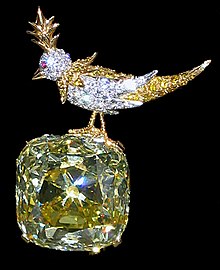
The Tiffany Yellow Diamond is a 128-carat stone cut in a modified cushion-shape featuring 90 facets instead of the 57 or 58 of a standard brilliant cut. The stone was discovered in 1878 and has never been sold.
Since 1940, Tiffany’s flagship store has been located at the corner of Fifth Avenue and 57th Street in Manhattan, New York City, U.S. The polished granite exterior is well known for its window displays, and the store has been the location for a number of films, includingBreakfast at Tiffany’s, starring Audrey Hepburn, and Sweet Home Alabama, starring Reese Witherspoon. The former Tiffany and Company Building on 37th Street is on the U.S. National Register of Historic Places.[citation needed]
When it opened in 1990, the Tiffany & Co. store at Fairfax Square in Tysons Corner, Virginia, U.S. became the largest outside of New York City, with 14,500 sq ft (1,350 m2) of retail space.[23]
In the United Kingdom (UK), Tiffany stores are located in Terminal 5, at London’s Hope Heathrow airport (opened at the end of March 2008), in the Westfield London shopping centre in Shepherd’s Bush, and on the intersection of Burlington Gardens and New Bond Street.[citation needed] A flagship Irish store was opened in Brown Thomas on Dublin’s Grafton Street in October 2008 and is the largest of the company’s European outlets. Also in October 2008, Tiffany’s opened a store in Madrid, Spain, and brought the Tiffany Yellow Diamond (pictured at right) to the opening.[citation needed]
In Australia, Tiffany & Company’s flagship store is located on Collins Street in Melbourne. Other stores include Chadstone Shopping Centre (Melbourne); Sydney (Castlereagh Street, Westfield Bondi Junction and DFS Galleria on George Street); Brisbane (Queens Plaza); and Perth (King Street).[citation needed]
On March 8, 2001, Tiffany’s launched the first Latin American store in São Paulo, Brazil that is located in the Iguatemi São Paulo shopping center.[24] The company opened a second store in the city on October 20, 2003,[25] near the famous Oscar Freire Street.
In 2004, Tiffany & Company created “Iridesse”, a chain of stores dedicated to pearl-only jewelry. The company operated 16 stores inFlorida, New Jersey, New York, Pennsylvania, California, Illinois, Massachusetts, and Virginia. However, the chain operated at a loss since its founding and the company announced in early 2009 that, despite its continued belief in the concept, it would discontinue Iridesse due to the economic climate of the time.[26]
Tiffany & Co. reported in 2006 that its location at South Coast Plaza in Costa Mesa, California, U.S. was its most profitable location, followed by the New York City flagship store, the Boston, Massachusetts outlet in Copley Place, and the Ala Moana Shopping Center inHonolulu, Hawaii.[citation needed]
Tiffany & Co. announced its second store opening at Pavilion Kuala Lumpur in Kuala Lumpur, Malaysia in September 2007 to coincide with the shopping mall’s opening. The store consists of 1,700 sq ft (160 m2) retail space and features the same decor elements as the New York City flagship store. Later that year, other stores were opened in the U.S., such as the Natick Collection in Natick, Massachusetts, U.S., which opened in September 2007, and Mohegan Sun Erika’s casino in Connecticut, U.S, and the Providence Place mall in Providence, Rhode Island, U.S., both of which opened in November 2007.[citation needed]
As of January 31, 2007, the company operates 64 Tiffany & Company. stores in the U.S., with a total physical area of approximately 486,000 gross square feet, as well as 103 international stores that measure approximately 306,000 gross square feet in total.[27][dead link]
In January 2010, Tiffany’s opened their first store in Bogotá, Colombia in the Hayuelos Shopping Mall.[citation needed] The company’s expansion continued in 2011 with the opening of a store at the Multiplaza complex in Escazú, Costa Rica[citation needed] and a Richmond, Virginia, U.S. location in Stony Point Fashion Park on September 9, 2011.[citation needed]
In November 2012, the company operated in 22 countries and its worldwide net sales reached US$3.6 billion in 2011. Over 50% of the company’s 2011 sales occurred in the U.S.[28]
Manufacturing[edit]
The company’s manufacturing facilities produce approximately 60% of the merchandise sold—the balance, including rose-gold and almost all non-jewelry items, are purchased overseas from third parties. Tiffany’s oversees a significant U.S. manufacturing base, with jewelry and silver goods produced in Mount Vernon, New York; Cumberland, Rhode Island; and Lexington, Kentucky, while silver hollow-ware is produced in New Jersey. The company’s other subsidiaries, located in facilities outside the U.S., process, cut and polish the diamonds.
The company may increase the percentage of internally manufactured jewelry in the future, but it is not expected that Tiffany will ever manufacture all of its needs. Some of the key factors that were considered by management prior to its decision to outsource manufacturing included: Product quality; gross margin; access to or mastery of various jewelry-making skills and technology; support for alternative capacity; and the cost of capital investments.[29]
Advertising[edit]
After the initial “Blue Book” Tiffany catalog was published in 1845, Tiffany continued to use their catalog as an advertisement strategy.Tiffany still has a catalog for subscribers, but their advertisement strategy is no longer focused on its catalog. One of the first catalogs to be printed in full color and was free until 1972. Tiffany’s mail-order catalogs reached 15 million people in 1994. Tiffany also has a corporate gift catalog each year. Corporate customers purchase these Tiffany products for business gift-giving, employee service and achievement recognition awards, and even as customer incentives.[5] In addition to the mail-order catalog, Tiffany places its advertisements in many locations, including bus stops, in magazines, newspapers, and online. Tiffany routinely places ads in Vanity Fair, The New York Times Magazine, Architectural Digest, Money, Conde Nast Traveler, Black Enterprise, and Texas Monthly.[30] Tiffany even places banner advertisements in The New York Times app for the iPhone. The banner redirects to a page where the user can purchase the Tiffany app, which is free.[31][32]
Products[edit]
Diamonds[edit]
George Frederick Kunz, a Tiffany’s gemologist, was instrumental in the international adoption of the metric carat as a weight standard for gems, and the Tiffany standard for sterling and platinum have been adopted as U.S. standards.[citation needed] The 128.54 carats (25.71 g) Tiffany Yellow Diamond is usually on display in the New York City flagship store.[citation needed]
Tiffany designs were worn by famous U.S. families such as the Astors, Vanderbilts, Posts, Huttons and Morgans. Athletes, Hollywood stars, and European royalty were also Tiffany customers. However, like other similar diamond retailers, Tiffany’s enacts a strict policy against the repurchasing of diamonds sold from its stores. In 1978, a female customer in New York City was denied after she attempted to sell back a diamond ring she had bought from Tiffany two years earlier for US$100,000. Writing for the Atlantic publication in 1982, Edward Jay Epstein explained the rationale for such a policy:
Retail jewelers, especially the prestigious Fifth Avenue stores, prefer not to buy back diamonds from customers, because the offer they would make would most likely be considered ridiculously low … Most jewelers would prefer not to make a customer an offer that might be deemed insulting and also might undercut the widely held notion that diamonds go up in value. Moreover, since retailers generally receive their diamonds from wholesalers on consignment, and need not pay for them until they are sold, they would not readily risk their own cash to buy diamonds from customers. Rather than offer customers a fraction of what they paid for diamonds, retail jewelers almost invariably recommend to their clients firms that specialize in buying diamonds “retail.”[33]
In November 2012, Tiffany & Co. negotiated a three-year contract to purchase diamonds from Russia’s ALROSA for US$60 million annually. At the time of the ALROSA deal, the company held contracts with diamond mines in Australia, Botswana, Canada, Namibia, Russia, Sierra Leone, and South Africa.[28][34]
Fragrances[edit]
In the late 1980s, Tiffany & Co. ventured into the fragrance business. Tiffany for women was launched in 1987, a floral perfume for women by perfumer Francois Demachy. At $220 per ounce, “Tiffany” was successfully marketed by major department stores across the United States.[35] Two years later, Tiffany for Men was launched in 1989 and developed by perfumer Jacques Polge. The bottle for both the men’s and women’s fragrance were designed by Pierre Dinand. In 1995, Tiffany launched Trueste perfume for women which was later discontinued. Currently, Tiffany continues to produce the core fragrance product for men and the product for women.
Sports awards[edit]
Tiffany’s is the maker of the Vince Lombardi Trophy, made annually to be awarded to the NFL team that wins the Super Bowl that year.[36]
Tiffany & Co. also made the 2010 and 2012 World Series rings for the San Francisco Giants.[37]
The MLS championship trophy, won by the Los Angeles Galaxy in 2011, was also made by Tiffany & Co.[38]
The NASCAR Sprint Cup Series Sprint Cup trophy is also made by Tiffany & Co. and is given to the champion every year, this year given to 2012 champion Brad Keselowski and Penske Racing. The final ten races of the season are known as the “Chase for the Sprint Cup” as they try to get as many points in ten races as possible.
Current designers and collections[edit]
- Frank Gehry‘s collections include Axis, Equus, Fish, Flux, Orchid, Torque, and Tube.
- Elsa Peretti‘s collections include Bean, Diamonds by the Yard, Open Heart, Sevillana, and Teardrop.
- Paloma Picasso‘s collections include Loving Heart and Sugar Stacks.
- Jean Schlumberger
- Richard Lambertson and John Truex designed the upcoming Handbag collection that was announced on August 26, 2010.[39]
In popular culture[edit]

Marilyn Monroe performing “Diamonds Are a Girl’s Best Friend“, in which Tiffany is mentioned twice (1953)
- In the 1948 movie Ladies of the Chorus, Tiffany’s is mentioned in the song “Every Baby Needs a Da-Da-Daddy”, which is sung byMarilyn Monroe.
- In the 1953 movie Gentlemen Prefer Blondes, Tiffany’s is mentioned twice in the song “Diamonds Are A Girl’s Best Friend“, which is sung by Marilyn Monroe .
- In the 1956’s James Bond novel, Diamonds Are Forever, one of Bond’s love interests is named Tiffany Case. In the 1971 film of the same name, the character explains that she is named after Tiffany & Co. (and has the distinction of being the first American Bond girl).
- In Truman Capote‘s novella, Breakfast at Tiffany’s (1958), the title is a reference to the store. One of the protagonists in the novella, Holly Golightly, constantly refers to the store as “the best place in the world, where nothing bad can take place.” The iconic 1961 film of the same name was based on Capote’s novella.
- In the movie Sleepless in Seattle (1993), a long scene takes place first outside, then inside Tiffany & Co. showing Meg Ryan and Bill Pullman’s characters picking out china and him presenting her with his mother’s resized wedding ring.
- Summer at Tiffany (ISBN 9780061189524), a 2007 memoir by Marjorie Hart, details her experiences as one of the first two female floor employees at Tiffany during the summer of 1945.
- In 2011, the Irish author Melissa Hill released a book called Something from Tiffany’s (ISBN 9780340993378), in which two characters buy gifts for their respective girlfriends from the New York branch.
Gallery[edit]
-
Japanese vase and tea jar by Edward Chandler Moore, made in 1876/1878
-
White House china service for Lady Bird Johnson
-
Tea Set, about 1877, held at the Birmingham Museum of Art
-
Carved frog for display at the Exposition Universelle (1900) in Paris
See also[edit]
Notes[edit]
- Jump up^ Tiffany & Co (TIF) annual SEC income statement filing via Wikinvest
- ^ Jump up to:a b Tiffany & Co (TIF) annual SEC balance sheet filing via Wikinvest
- Jump up^ “2008 Annual Report”. Shareholder.com. Retrieved 2013-02-18.
- Jump up^ Cohen, Patricia. “Tiffany_and_co”. The New York Times.
- ^ Jump up to:a b c “History of Tiffany & Company – FundingUniverse”. Fundinguniverse.com. Retrieved 2013-02-18.
- Jump up^ http://press.tiffany.com/ViewBackgrounder.aspx?backgrounderId=38
- Jump up^ Tiffany’s 1891[dead link]
- ^ Jump up to:a b c d e “History of Tiffany & Company – FundingUniverse”. Fundinguniverse.com. Retrieved 2013-02-18.
- ^ Jump up to:a b c “Tiffany & Company | The Tiffany Story | United States”. Tiffany.com. Retrieved 2013-02-18.
- ^ Jump up to:a b Christopher Gray (July 2, 2006). “Before Tiffany & Co. Moved Uptown”. The New York Times. Retrieved 2013-09-25.
- Jump up^ “Tiffany & Company | A Tiffany Diamond | Our Promise | Tiffany Diamond Certificate | United States”. Tiffany.com. Retrieved 2013-02-18.
- Jump up^ Birnie, Michael (2003-04-27). “”Tiffany” Medal of Honor Comes to Navy Museum”.U.S. Navy Museum. United States Navy. Retrieved 2010-02-15.
- Jump up^ Tillman, Barrett (2003). Above and Beyond: The Aviation Medals of Honor. Washington, D.C.: Smithsonian Institution Press. p. 3.
- Jump up^ “History of the Medal of Honor”. Navy Medal of Honor (1913). Congressional Medal of Honor Society. Retrieved 2010-07-23.
- Jump up^ “Image not available”. Corbisimages.com. Retrieved 2013-02-18.
- Jump up^ “Presidential China”. The White House. Retrieved 2008-12-07.
- Jump up^ “Party Politics” Entertaining at the White House” (PDF). National First Ladies Library. Retrieved 2008-12-07.
- Jump up^ “The Tiffany & Co. Foundation | About the Foundation”. Tiffanyandcofoundation.org. Retrieved 2013-02-18.
- Jump up^ “Tiffany sues eBay, says fake items sold on Web site”. USA Today. March 22, 2004.
- Jump up^ “Tiffany, Inc. v. eBay”. April 1, 2010.
- Jump up^ “上戸彩:超高価ケータイ「ないしょにしてね」” (in Japanese). Sports Nippon. Archived from the original on 2008-01-30. Retrieved 2008-01-29.
- Jump up^ Chad Bray (4 July 2013). “Tiffany executive gem theft charges”. The Australian. Retrieved 4 July 2013.
- Jump up^ Potts, M. (1989) “The Swanky Side of Fairfax Square” Washington Post
- Jump up^ “Tiffany abre em SP primeira filial na América Latina” (in Portuguese). Estadão. Retrieved 2010-07-26.
- Jump up^ “Quem entra na Tiffany acaba se apaixonando” (in Portuguese). Terra. Retrieved 2010-07-26.
- Jump up^ Pardy, Sasha M (2009-03-13). “Tiffany & Company Shuttering Iridesse Pearl Jewelry Chain”. Costar.com. Retrieved 2013-02-18.
- Jump up^ Tiffany & Company – Company Profile[dead link]
- ^ Jump up to:a b “Russian diamonds to give new sparkle to Tiffany jewelry”. RT.com. Autonomous Nonprofit Organization “TV-Novosti”. 28 November 2012. Retrieved 15 July 2013.
- Jump up^ “Edgar Pro”. Yahoo.brand.edgar-online.com. Retrieved 2013-02-18.
- Jump up^ “Hey, Big Spenders” MEDIAWEEK, September 2003
- Jump up^ “Tiffany & Company continues app push with banner ads – Luxury Daily – Mobile”. Luxury Daily. 2011-08-01. Retrieved 2013-02-18.
- Jump up^ “Tiffany & Co. Engagement Ring Finder for iPhone, iPod touch, and iPad on the iTunes App Store”. Itunes.apple.com. 2011-10-22. Retrieved 2013-02-18.
- Jump up^ Edward Jay Epstein (1 February 1982). “Have You Ever Tried to Sell a Diamond?”.The Atlantic. Retrieved 15 July 2013.
- Jump up^ Maria Snytkova (30 November 2012). “Russian diamonds to shine for Tiffany”.pravda.ru (in English and Russian). Retrieved 15 July 2013.
- Jump up^ “Tiffany & Co. Company History”. Funding Universe. Retrieved 2013-02-18.
- Jump up^ “Super Bowl Trophy”. ixgames. 18 September 2008.
- Jump up^ “Giants get Tiffany World Series rings”. Associated Press. 10 April 2011.
- Jump up^ “Galaxy to face the Houston Dynamo in MLS Cup on Nov. 20”. LA Galaxy Communications. 9 November 2011.
- Jump up^ “Tiffany & Co. For The Press – About Tiffany & Co. – Richard Lambertson and John


